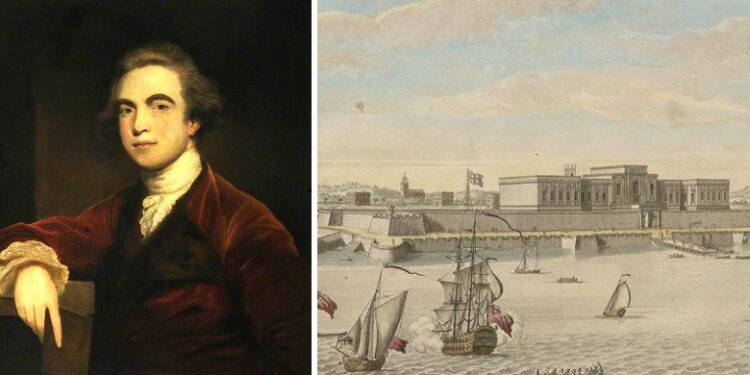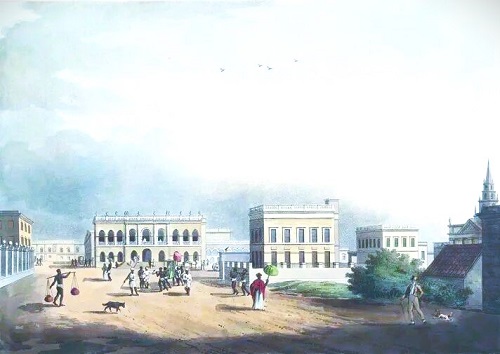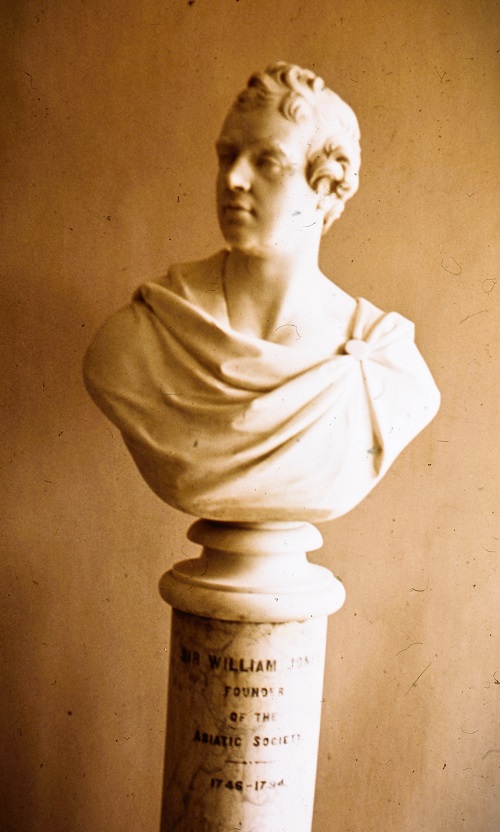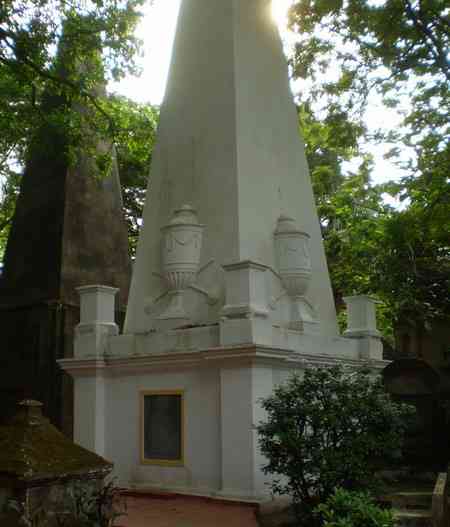
Born on 28 September 1746, William Jones founded the Asiatic Society of Bengal on 15 January 1784
By Zaffar Junejo
A mindful reader, prior to reading the next paragraphs, might ask to summarize William Jones’ profile before his voyage to India. Without any hesitation, I would consult S.N. Mukherjee’s book Sir William Jones: a Study in Eighteen-century British Attitudes to India, and quote: “[William Jones] was an Orientalist at 22; The Royal Society’s Fellow at the age of 26; a member of Dr. Johnson’s famous Club at 27; the first English scholar to master Sanskrit, and the pioneer of Sanskrit learning, and honored to be a judge of the Supreme Court of Calcutta at the age of 34.”
William Jones, along with his wife, Anna Maria Shipley, whom he married just four days earlier, voyaged to India on the 12th of April 1783. But before their voyage some important events happened: he was knighted on the 20th of March 1783 so he became Sir William Jones. On the 4th of April 1783 he was appointed as a judge; on the 8th of April he married Anna Maria Shipley.
Meanwhile, in 1782, his published a translation of pre-Islamic Arabic odes of seven poets known as The Moallakat. Its full title was The Moallakat or Seven Arabian Poems, Which Were Suspended on the Temple at Mecca, with a Translation and Arguments. The book became very popular, although it was written in prose form. The book indicated his deep and critical knowledge of Arabic language.
The Joneses went with their planned voyage to India. Surely, the couple must have faced some discomforts such as diseases, storms, shortage of water and food supplies. But Jones was happy, and continued his study of law, Persian and anything related to India. His recreation was chess, conversation with his wife and hearing stories from Captain Williamson and other crew members who had been to India more than once. The voyage and ample time stimulated him to prepare an “Oriental-Andrometer” with the title of Objects of Enquiry during my Residence in Asia (the document is famous with the more brief name Objects of Enquiry). In a sense, it was his ‘guide-list.’ It contained 16 points that clearly showed his future commitments. In fact, almost all points revolved around ancient India, its judiciary, culture, knowledge and languages.

In August 1783, the Crocodile was sailing through the Arabian Sea. In a stimulating evening – with the cool breeze of the Arabian Sea, the closeness of his beloved wife, his ignited mind, and superb advocate’s training – he thought about the realization of his envisaged scheme drawn under the Objects of Enquiry. He was fully aware about the demands of the task: the vastness of the area, the scale of the needed efforts, and lack of coordination among European scholars (based in India). Therefore, he came up with an idea to help establish an organization of Europeans in Bengal who could systematically investigate all fields, and in doing so, cooperate with each other. However, he didn’t forget the spirit of enhancing cultural understanding between Asia and Europe, and multidirectional advancement of knowledge in the listed fields.
Generally, it is believed that on that evening the Asiatick Society (popularly called the Asiatic Society of Bengal) was born.
The Crocodile touched the Indian shore and anchored in Madras. Jones were welcomed by George Lord Macartney (also spelled George McCartney) Governor General of Madras. Finally, after the five-month voyage, the ship reached Chandpal Ghat, at the foot of Esplanade Row, Calcutta (now Kolkata) on the 25th of September 1783. Encouragingly, William Jones was already known to Indian scholars as a linguist and oriental scholar. At Fort William, he was enthusiastically received by attorneys, advocates, executive and judicial administrators, as well as Company officers.
William Jones’ presidential discourses played the leading role. These lectures served two purposes: to set the Society’s research agenda, and secondly appeal to the general public to indulge in reading, writing and research.
William Jones in his first encounters and subsequent social gatherings succeeded in giving the message that he was neither a representative of the Tory Party, nor of the Whigs – nor, for that matter, part of any faction of the Company. After swearing in as a judge, he made his first charge before the grand jury next day. He highlighted the problems of judicial and executive functions and reminded them of the duty of the Supreme Court. After some time, he told Robert Chambers (at that time he was Chief Justice of the Supreme Court of Judicature at Fort William in Bengal) about the Society that he had envisioned. Sir Robert Chambers appreciated the idea and invited a group of people to meet. In response to his call, 30 European scholars and gentlemen of Calcutta interested in the Indian society gathered on Thursday, the 15th of January 1784 in the Court house of the Grand Jury. Among them were H. Hyde (the Royal Engineers/British Army and Indologist), General John Carnac (former Commander-in-Chief of the army of the Company), Francis Gladwin (Persianist, Professor of Persian at Fort William College), Thomas Law (Expert on Revenue and Finance), Jonathan Duncan (Company’s official and promoter of Sanskrit language) and Charles Wilkins (Orientalist and typographer).

Sir Robert Chambers presided over the meeting and William Jones delivered a speech in which he emphasized the lack of “the institution of a Society for enquiring into the history, civil, natural, the antiquities, arts, sciences and literature.” He also defined the geographical focus of the Society to be the geographical limits of Asia. He elaborated that “within these limits, enquires will be extended to whatever is performed by man and produced by nature.” The practice of the Royal Society in London of having a patron was also adopted. The patron of the Royal Society in London was the King. Thus, Asiatic Society invited Mr. Warren Hastings (1732-1818), Governor General of Bengal, to accept the position of the president of the Society. Although Hastings initially declined, with the suggestion that it suited a gentleman (i.e. William Jones) who was capable of realizing its objectives, he later accepted the position of patron.
There is no doubt that lots of scholars contributed to enrich the Society’s agenda, but William Jones’ presidential discourses played the leading role. These lectures served two purposes: to set the Society’s research agenda, and secondly appeal to the general public to indulge in reading, writing and research. However, it was also believed that all these discourses were William Jones’ reflections over his last year’s studies. In total, he delivered eleven discourses.
The details of these discourses, along with topics and dates are as follows: the importance of Asia among mankind, need for the Society (Discourse I, of 24 February 1784), history, laws, manners, arts and antiquities of Asia (Discourse II of 24 February 1785), Hindu history of ancient world: cultural, linguistic and religious issues in Indian research (Discourse III of 02 February 1786), Arabian society and culture (Discourse IV of 15 February 1787), the boundaries of Tatary and the Mongols (Discourse V of 21 February 1788), the Persians, their ancient language and character (Discourse VI of 19 February 1789), the Chinese before Tatary, and their language and literature (Discourse VII of 25 February 1790), the Borders, Mountains and Islanders of Asia (Discourse VIII of 24 February 1791), Origin and families of nations (Discourse XI of 20 February 1792), Asian history and science (Discourse X of 28 February 1793) and the philosophy of the Asiaticks (Discourse XI of 20 February 1794).
All of William Jones’ discourses roamed around his Objects of Enquiry scheme that he had devised during his voyage to India. The successive discourses were expanded and new subjects were added each year. Some of them looked like reports. However, a few seemed like a Guru’s addresses to his Chelas or disciples. Although most of them were inspiring, and were linguistic in nature, he talked a lot about comparative analysis of cultures. Others yet were speculative and reflective. However, his discourses were part of his personality trait– to be a proceduralist.
William Jones in his young age strove to copy the style of Cicero, and in India he examined himself without a break, and scheduled his days, even in vacations, like this: mornings were reserved for writing a letter and reading ten chapters of the Bible, as well as the learning of Sanskrit Grammar and Hindu law, afternoons were set aside for readings of Indian Geography, and evenings were dedicated to Roman History, Aristotle and Chess.
Professor Acharya Suniti Kumar Chatterjee in his presidential address delivered on the 1st of February 1971, highlighted that William Jones established an academic research culture, and introduced Western intellectual enquiry methods into the Eastern traditions. He summarized that Jones’s work and ideas in a way helped to set a fertile ground for various organizations and associations to sprout, including the Archaeological Survey of India.
Till this day, scholars value his contribution to linguistics, particularly his “proposition of the existing of a relationship between Indo-European languages.” They are of the view that William Jones’s contribution separated languages from religious fetters, and gave the study of linguistics a proper rational footing.
Death and afterwards

Ultimately, living in Calcutta’s climate took its toll on the health of William Jones and Anna Maria. In November 1793, Anna Jones was compelled to go back to England for health reasons. William Jones stayed back in Kolkata to complete his translation of Muslim and Hindus laws. He told Anna that the task would take two more years. William Jones, after Anna’s return, lived alone in his home at Garden Reach in Calcutta. He died on 27 April 1794 due to liver inflammation.
In London, Anna Maria Jones was not aware about her husband’s death, even on the day of her husband’s funeral in Calcutta. She was still unpacking in Bolton Street, London to be at ease after a long voyage.
A month later, Mr. Edmund Morris, secretary to the Society, issued a notice about the selection of a new President. The notice elaborated that a meeting of the members was called on the 1st of May 1794. The members unanimously agreed to constitute a committee to finalize the name of the president. Sir John Shore was requested to accept the office. He agreed, and on the 22nd of May 1774 he took the seat of the president. Sir John Shore, in his first Discourse (which was the 12th discourse in the series) praised William Jones’s role to conceive the Society and set its standards. He also talked about William Jones’ handwritten Desiderata (literal meaning: “Things that are Desired”), found after his death. (Concludes)
______________________
 Dr. Zaffar Junejo is Research Scholar, Department of History University of Malaya, Malaysia. Mr. Junejo apart from scholarly contribution also writes for popular media. He could be accessed at: Email junejozi@gmail.com, Cell/WhatsApp +92 334 045 5333 Skype Zaffar.Junejo Facebook facebook.com/zaffar.junejo
Dr. Zaffar Junejo is Research Scholar, Department of History University of Malaya, Malaysia. Mr. Junejo apart from scholarly contribution also writes for popular media. He could be accessed at: Email junejozi@gmail.com, Cell/WhatsApp +92 334 045 5333 Skype Zaffar.Junejo Facebook facebook.com/zaffar.junejo
Courtesy: The Friday Times Naya Daur Lahore (Published on January 17, 2023)
Click here for Part-I